Religion and Belief System
![]()
...De Ayer
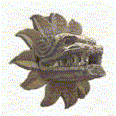
Creation Myths
The Lacandon have several different version of the Creation story. In one version, the first people were built of clay with teeth of corn, but they all died. The next descended from Yaxté (ceiba, silk cotton tree) but they too died. The people that exist today are the hybrid children of the clay and the Yaxté (Duby 295).
In a variation to the above story, the people that exist today were created from maize and the blood of the gods (Rittlinger 96).
Yet another story tells us that Hachakyum made the Lacandon and all the plants existing before the Spanish came and Yantho made the white men, cows, and wheat. In another telling Metzabok made the white men and the things belonging to them (Duby 295).
A third explanation of human variation was that Kisin also made people, gut Hachakyum found out and was angry. He turned Kisin's people into animals. In retaliation, Kisin painted Hachakyum's people dark So that today the Lacandon are dark skinned (Duby 295).

Cosmology
The 5 layers of the universe:
U Ka'ani Chembel K'uh- "The Minor Gods Sky." This realm is the highest heaven and outermost layer of the universe. It is very high and very good. It is ruled by the god Chembeku, and his wife U Na'il Chembeku the most powerful gods (Duby 295). The minor gods also reside here. It is very dark and cold in U Ka'ani Chembel K'uh because there is no sun (Hach Winik).
U Ka'ani K'akoch- "K'akoch's Layer of Sky." This realm is the middle heaven. Where Kakoch and U Na'il Kakoch- the "gods of the gods"- dwell. This layer has its own sun (Duby 295, Hach Winik).
U Ka'ani K'uh- "The Celestial God's Sky." This realm is the lowest heaven. This is where Lacandon go after they die where they live happily and have whatever they want. It is ruled by Hachakyum and U Na'il Hachakyum- the most important deities to the Lacandon (Duby 295). The celestial gods live in this layer, including the sky, stars, moon, and sun which are comprehensible to humans (Hach Winik).
Lu'um
K'uh- The surface of the earth. It is inhabited by humans,
animals, and the terrestrial deities (Hach Winik).
Yaralum- a.k.a. Yalam Lu'um, "The Underworld." Beneath the surface of the Earth is Yaralum. Yaralum is ruled by Kisin, his wife U Na'il Kisin, his rival Sukunkyum, and Sukunkyum's wife U Na'il Sukunkyum. Kisin is evil and angry, and his fits of anger are expressed as earthquakes. Wicked people are punished in Yaralum. Sukunkyum judges souls of the dead, and Kisin punishes the wicked. Sinners burn forever, are trapped in ice, or are transformed into animals bound to eternal labor (Duby 295, Hach Winik).
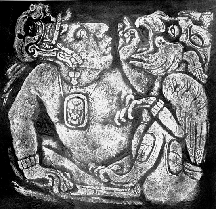
The Lacandon Maya Pantheon
Ackyum- see Hachakyum
Ak K'ak'- a.k.a. K'ak. Whose name means "Fire". Ak K'ak' was the Maya god of war in Prehispanic times. Today the Lacandon affiliate him with diseases- especially small pox and measles (known as k'ak' in Lacandon). Ak K'ak''s transformation from a god of war to a god of disease and of fever may have to do with the epidemics the Spanish Conquistadors brought when they arrived in the New World. Additionally, the Lacandones consider Ak K'ak' a carrier of disease because of these diseases' symptoms- red skin eruptions and fever- which are associated with fire. The Prehispanic Maya portrayed Ak K'ak' as a god carrying a torch and a spear. Ak K'ak' lives on a lake connected with a canal, and he is often prayed to in times of sickness. He is Metzabok's neighbor (Duby 295-296, Hach Winik).
Äkyantho'- see Yantho the White.
Bor- Bor is the god of balché (an alcoholic drink made of fermented sugar and bark of the balché tree used traditionally for ritual occasions) (Duby 281-296).
Bulha'kilutalk'in- The Hahanak'uh of the East or the "Flood waters from where the sun is seen to come" (Hach Winik).
Chac Mol- see Metzabok
Ch'ik'ink'uh- The Hahanak'uh of the West or the "God that eats the sun" (Hach Winik).
Chembeku- Chembeku is the highest god. He is very good, and rules the highest of the heavens. However, he has no censer and no one ever prays to him (Duby 295).
Cizin- see Kisin
Hachakyum- a.k.a. Hachäkyum, Hachäkyuum, Yumbrikan, Nohotsakyum, Ackyum, and Itzamna. "Our True Lord," Hachakyum is the most important Lacandon deity. He was born in U Ka'ani K'akoch from a seed that Kakoch placed in the ground. He then- depending on which account you read- created the world, or made the already existing world livable. He created the jungle, the animals- and with the assistance of his wife, Nai Hachakyum, human beings. He is also created the underworld for his brother, Sukunkyum. He is all-powerful and omnipresent. The incense burner is named after him, and he is thought to be embodied in it as well. He walks at night over the Milky Way, and the stars are seeds of plants belonging to him. He resides at Yaxchilan in the form of a headless god. If he ever puts his head back on, the jaguars will destroy the world (Duby 295, Hach Winik).
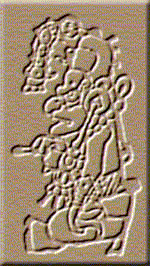
Hachakyum
Hachäkyum- see Hachakyum
Hachäkyuum- see Hachakyum
Hahanak’uh- Also called the "Water House Gods" The Hahanak'uh are demigods that assist Metzabok, and are responsible for thunder and lighting. They spread Metzabok's black powder through the clouds with macaw feather wands, making the clouds dark with rain. Each is associated with a direction. When the god Kisin insults them by raising his xikul (tunic) and mooning them, they throw their stone ax heads at him in anger. The ax heads create thunder and lightning when they strike the ground. Occasionally Lacandon hunters find these ax heads in the jungle, and show them in order to prove this story true. The Hahanak'uh are Bulha'kilutalk'in, Ch'ik'ink'uh, Xämän, Nohol, Tseltsel Xämän, and Tseltsel Nohol (Hach Winik).
Hun Hunahpu- the maize god (Criscenzo Jaguar Sun).
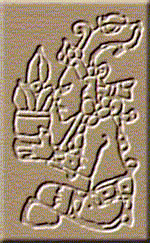
Hun Hunahpu
Hunab Ku- see Kakoch
Itzamna- see Hachakyum
K'aak' Bäkal äk Yum Chäk Xib- The "Red Man K'aak' Meat of Our Lord" is the eldest son of Hachakyum and Nai Hachakyum. He and his brother, Paal äk yum Chäk Xib, have been banished to the forest, without the honor given to other gods, because they tried to steal their father's throne (Hach Winik).
K'ak- see Ak K'ak'
K’akoch- see Kakoch
K’in- K'in is the Sun God. As her travels through the sky, he expends his energy and becomes ever weaker until sunset when he descends into Yaralum and dies. At night, Sukunkyum cares for K'in, feeds him, and carries him through the underworld on his back from west to east. He resurrects K'in and cares for him so that the next day, K'in may be strong and rested and begin his journey across the sky once more (Duby 295, Hach Winik).
Various images of the sun god.
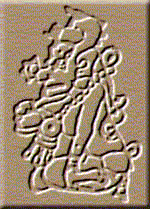
Kakoch- a.k.a. K’akoch, Xpiyacoc, and Hunab Ku. Kakoch is the Lord of U Ka'ani K'akoch, the supreme creator, and the father of the gods. He created the earth, the sun, and the bak nikte' (Plumeria rubra), the flower from which the Lacandon gods were born. Only one Lacandon owns a Kakoch censer, and it is said that nobody ever prays to him, because he remains aloof, and unconcerned with human affairs. He watches over the gods as the gods watch over the Lacandon. Kakoch is the god that the gods worship and make offerings to (Duby 295, Hach Winik, Vann Characteristics of the Lacandon).
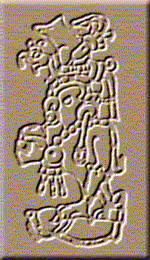
Kakoch
Kayum- The god of singing and dancing (Duby 296).
Kisin- a.k.a. Cizin (Criscenzo Jaguar Sun). The evil Lord of Yaralum. He is the god of death and earthquakes. Evil and angry, he rocks the earth with his fits of anger. Kisin wants to destroy the world. He tries to kill K'in, the sun, as he passes through the underworld each night. If the soul of a dead person is judged to have been wicked by Sukunkyum- if a person lied, stole, murdered, or committed incest- their soul is given to Kisin who punishes them by alternately burning and freezing them (Duby 295, Hach Winik).
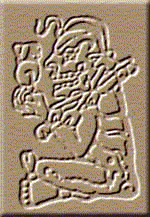
Kisin
Mansabak- see Metzabok
Mensäbäk- see Metzabok
Metzabok- a.k.a. Mansabak, Mensäbäk, Chac Mol, and Yum Chac. His name meaning "Maker of Powder", Metzabok is the god of lightning, thunder, and rain. He is unknown among the Jatate River Lacandon, but is one of the more important gods to the Northern group. He is not considered to be an entirely benevolent deity, and is often accused of causing illness. The sick will try to appease him by burning copal or making a pilgrimage to the lake where he resides. Metzabok makes a black powder that he gives to his assistants, the Hahanak'uh who spread the powder throughout the sky, making rain (Duby 295, Hach Winik). In another version, he drips or sneezes out abundant moisture from his long, runny nose (Rittlinger 96).
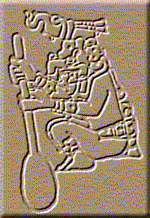
Different images of the rain god.
Nai Hachakyum- a.k.a. U Na'il Hachäkyum, Xka'lr'ox, U Na'il Hachakyum, U Na'il Yumbrikan, U Na'il Nohotsakyum, U Na'il Ackyum, and U Na'il Itzamna. "She of the Breadnut Leaves." The wife of Hachakyum, and co-creator of human beings. She has three children- K'aak' Bäkal äk Yum Chäk Xib, Paal äk yum Chäk Xib, and T'uup (Duby 295, Hach Winik).
Nohol- The Hahanak'uh of the South (Hach Winik).
Nohotsakyum- see Hachakyum
Okna- Okna is the Moon, and the goddess of fertility. As the moon travels through the sky, she expends energy. She becomes weaker until she sets, descends into the underworld, and dies. Sukunkyum then cares for her, brings her back to life, and carries her across Yaralum every day so that she may rise the next evening strong and rested (Duby 296, Hach Winik).
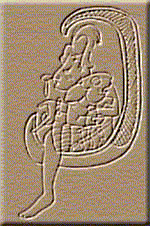
Okna
Paal äk yum Chäk Xib- The "Red Man Son of Our Lord" is the son of Hachakyum and Nai Hachakyum. Both he and his brother, K'aak' Bäkal äk Yum Chäk Xib, were banished because they tried to usurp their father's place among the gods. As punishment they were both forced to live in the forest without the honors bestowed to the other gods (Hach Winik).
Sukunkyum- a.k.a. Usukum. Sukunkyum is the chief lord of Yaralum, and the judge of souls- he gives evil souls to Kisin to torture. He was the first god to be born from the bak nikte' flower, thus making him the older brother of Hachakyum- indeed his name literally means "Older Brother of Our Lord." Sukunkyum is also the guardian of the sun and moon. When K'in traverses Yaralum by night and Okna passes through during the day, Sukunkyum must protect them from the evil lord Kisin who wishes to destroy them and cause the end of the world. He resurrects the sun and moon, feeds them, and carries them on his back through the underworld. So they may continue their journeys across the sky (Duby 295, Vann Characteristics of the Lacandon, Hach Winik).
T'uup- The youngest son of Hachakyum and Nai Hachakyum and the master of the sun (Hach Winik).
Tseltsel Nohol- The Hahanak'uh of the Southeast (Hach Winik).
Tseltsel Xämän- The Hahanak'uh of the Northeast (Hach Winik).
Tzibana- This god lives on a third lake near K’ak and Metzabok (Duby 296).
U Na'il Ak K'ak'- see U Na'il K'ak
U Na'il Ackyum- see Nai Hachakyum
U Na'il Bor- Goddess of balché. The wife of Bor (Hach Winik).
U Na'il Chac Mol- Goddess of rain, wife of Chac Mol (Hach Winik).
U Na'il Chembeku- The wife of Chembeku (Hach Winik).
U Na'il Cizin- see U Na'il Kisin
U Na'il Hachäkyum- see Nai Hachakyum
U Na'il Hachakyum- see Nai Hachakyum
U Na'il Hun Hunahpu- the maize goddess, wife of Hun Hunahpu (Hach Winik).
U Na'il Hunab Ku- see U Na'il Kakoch
U Na'il Itzamna- see Nai Hachakyum
U Na'il K'ak- a.k.a. U Na'il Ak K'ak'. Goddess of fire. The wife of K'ak (Hach Winik).
U Na'il K’akoch- see U Na'il Kakoch
U Na'il Kakoch- a.k.a. U Na'il K’akoch, U Na'il Xpiyacoc, and U Na'il Hunab Ku. The wife of Kakoch, and goddess of U Ka'ani K'akoch (Hach Winik).
U Na'il Kayum- The goddess of singing and dancing, wife of Kayum (Hach Winik).
U Na'il Kisin- a.k.a. U Na'il Cizin. The goddess of death and earthquakes, wife of Kisin (Hach Winik).
U Na'il Mansabak- see U Na'il Metzabok
U Na'il Mensäbäk- see U Na'il Metzabok
Na'il Metzabok- a.k.a. U Na'il Mansabak, U Na'il Mensäbäk, and U Na'il Yum Chac. The goddess of lightning, thunder, and rain. The wife of Metzabok (Hach Winik).
U Na'il Nohotsakyum- see Nai Hachakyum
U Na'il Sukunkyum- a.k.a. U Na'il Usukum The goddess of Yaralum, judge of souls, and wife of Sukunkyum (Hach Winik).
U Na'il Tzibana- the wife of Tzibana (Hach Winik).
U Na'il Usukum- see U Na'il Sukunkyum
U Na'il Xpiyacoc- see U Na'il Kakoch
U Na'il Yantho- a.k.a. U Na'il Äkyantho'. Goddess of foreigners and diseases. The wife of Yantho (Hach Winik).
U Na'il Yum Chac- see U Na'il Metzabok
U Na'il Yumbrikan- see Nai Hachakyum
Usukum- see Sukunkyum
Xämän- The Hahanak'uh of the North (Hach Winik).
Xka'lr'ox- see Nai Hachakyum
Xpiyacoc- see Kakoch
Yantho the White- a.k.a.. Äkyantho'. Also born before Hachakyum, Yantho is the god of foreigners and commerce. Yantho is responsible for all things foreign. He created the white men, sugar, wheat, medicine, hard liquor, cattle, horses, and disease. Yantho appears as a light-skinned foreigner wearing a hat and carrying a pistol just as foreigners do (Duby 295, Hach Winik).
Yum Chac- see Metzabok
Yumbrikan- see Hachakyum

Beliefs, Superstitions, and Taboos
Although over the years they have forgotten much of their religious practices and traditions, the Lacandon are still a deeply religious people with strong ties to the supernatural world. The Lacandon pray often and for many occasions- for good weather, fertility, in times of sickness, when going on a trip, or for the success of other enterprises. They will not eat produce of a new field before it has been offered to the gods (Duby 286). Before every meal, the community leader goes to the river and offers the first bowl of maize to the river god (Rittlinger 95-96).
The Lacandon believe that every person has two souls. One resides in the heart and is immortal. The other is in the foot and it frightens people, comes alive at night, and can cause the death of any person it meets (Duby 286).
They believe that spirits reside in stones- they are not necessarily good or evil- they merely exist. They call these stone spirits xtabai (which is interesting, because the Yucatec Maya have a similar concept for such stones, which they call tun. They also have the word xtabai, but it is not used for stones, but to refer to scary witches that kill men or drive them insane) (Duby 286, Kintz 157-158).
Women are believed to have great healing powers during pregnancy. When a woman is pregnant, it is forbidden to make a jaguar arrow, or to kill a jaguar (Duby 296). This probably has to do with the belief in nahuales- animal spirit "familiars" tied to the souls of human beings. Nahuales often come in the form of jaguars, so if a jaguar is encountered, it may be the nahual- the soul- of the mother or the child.
Because
human beings were created from maize, the Lacandon hold maize in great
reverence. Maize is a gift from Hun
Hunahpu,
the maize-god, and must only be used for food. It would be sacrilege to
photograph it or use it for barter (Rittlinger
96).

Rituals
Ritual is an important part of Lacandon life. Men from a caribal would often get together for religious ceremonies. Sometimes groups would gather "to make pilgrimages to Yaxchilan, where the most important gods live” (Duby 282).
However,
because of an unfortunate incident with a Priest (as discussed later),
resulting in the death of an important religious leader, the Lacandon have
lost a lot of their ritual knowledge. For
instance, there
used to be a puberty ceremony among the Jatate group, but it
hasn’t been done for a while. The nostrils of the boys were pierced so
they could put a feather through them. Only 3 men still had such
perforations and the northern group does not remember this ceremony (Duby
296).
“The
Jatate group used to live at Sökrum
(white earth) to be near the cave where K’in, the Sun, their main
god, disappears at night to make the trip through [the underworld]. They
used to have elaborate ceremonies with offerings of posol and balche to
the gods. The old priest, jealous of his power, waited too long to impart
his knowledge and died before fully instructing his son, and the most of
the traditions went with him. The people abandoned Sökrum
and now have only small god shelters with a broken censer” (Duby 292).
An important component of Lacandon ceremonies is the drinking of balché. However, since the discovery of cheap liquor, alcohol consumption among the Lacandon is now "no longer limited to ritual occasions" (Duby 281).The Lacandon burn offerings in censers for the gods. They may offer balché, posol, incense, maize, fruit, and on special occasions, the heart of a chicken (Rittlinger 96-97).
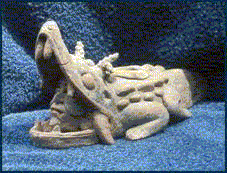
Sacred Material Culture
“The
ceremonial hut is the finest building in [a caribal]. It never has walls,
and several stools are its only furniture. Incense burners are kept on a
board under the roof and the bowls for the offerings of posol and balche
hang from the roof in nets. Bundles of bark also hang from the roof.
Copal, pine resin, and rubber are kept in gourds. Painted rattles, the
board for incense pellets, and balche bark hang from one of the house
poles. Hollow logs containing the fermenting balche are kept outside"
(Duby 285). Clay incense burners are designed with the face of the god it
feeds on it. They are molded, dried, fired, and then painted, using soot,
plant dyes, lime, and the achiote berry. Differences in painted design
signify whether the censer is designed for a god or goddess. Ceremonial
drums are also made of clay. These are adorned with the head of the
singing god Kayum. The
Jícaras for serving
balche and posol for religious purposes are decorated with intricate
figures. Rattles are decorated in a similar manner; they are mounted on
sticks and have bark streamers dyed with soot at the tips. They also make
flutes from hollow reeds with a feather quill at the tip fastened with
beeswax (Duby 286). Women weave intricate designs into their brocades as
part of their "sacred duty" ordained by the gods. They weave
diamond patterns representing the earth and sky, undulating designs such
as snakes or flowers to symbolize the fertile earth, patterns with three
vertical lines which connote the ancestors or the trickster monkeys, and
toads as icons of Metzabok (Maya Adventure).

Religious Organization
"The
northern group, lost all political and religious organization so long ago,
they can’t even remember ever having it. The Jatate and Cedro-Lacanha
used to have leaders and priests, but their numbers are so reduced that
that system collapsed" (Duby 290).
As
a sign of things to come, a
little before Duby's article was published, a few Lacandon in the
Cedro-Lacanha group became Protestants, calling themselves Evangelistas
(278-279).
![]()
...De Ahora
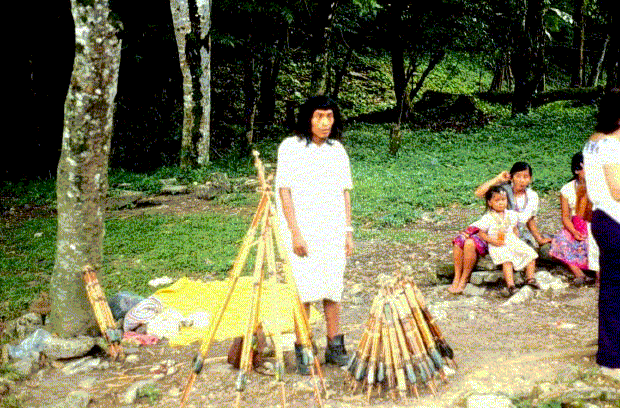
Unlike other Maya groups whose religion has been hybridized with Catholicism, the Lacandon have managed until recent times to resist invasion by missionaries (Criscenzo Jaguar Sun). By the time Duby's article was published the last attempt made by missionaries to force their conversion was made in 1790. To this day, the Lacandon have been highly resistant to invasion of missionaries that threatens their culture. Though changes and integration have been occurring. Resistance has been more successful in some communities then others.
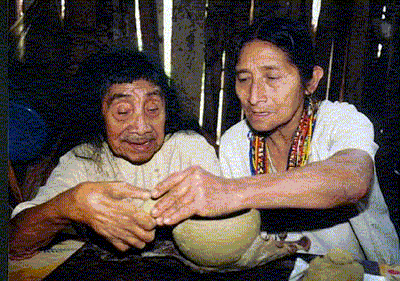
The
missionaries are successfully resisted in the Northern village of Najá.
According to Najá spiritual leader Chan K'in, to dismiss the gods denies
the identity and culture of the Lacandón people and censures their
history. Lacandón reverence for their gods has enabled the Lacandón of
Nahá to maintain their identity.
Najá was the home of the charismatic Chan K'in whose traditional influence helped sustain his people for three generations. He was the person to consult in order to interpret dreams, myths, or perform rituals to supplicate the gods (Hach Winik). No one person is as influential today as Chan K'in was. Chan K'in's father, was a T'ohil, or holy man. "Although Chan K'in was revered among his people, he always deferred to his father as the last T'ohil among the Lacandón" (Renshaw The Death of Chan K'in). He died in December 1996 at over 100 years old (Criscenzo Jaguar Sun). He was not in the ground before a Baptist minister tried to exploit his passing. He claimed that Chan K'in converted to Christianity before his death, and shook a video tape at the Lacandones offering it as proof that "'Hachäkyuum is worthless.' He implored the Lacandónes to accept Christ into their hearts and avoid the fires of hell. Undaunted, the Lacandónes ignored the ministers tearful pleas for Christ and his prayers for Chan K'in; they continued with their own traditional burial rites. In a rare show of unity, they reaffirmed their common culture and expressed their respect for Chan K'in. Chan K'in's two surviving widows denied his conversion. The video, most people of Nahá agree, is meaningless if it exists at all." Respect for Chan K'in forestalled evangelism long enough for his people to realize what they would lose if they converted- that if they were to abandon their beliefs and oral traditions they would forever sever their ties to their roots, and pride as a people (Renshaw The Death of Chan K'in). Today in Najá Lacandón elders continue to inspire the community with unique mythological stories, dream interpretations, rituals and agricultural principles that are purely Mayan (Hach Winik).
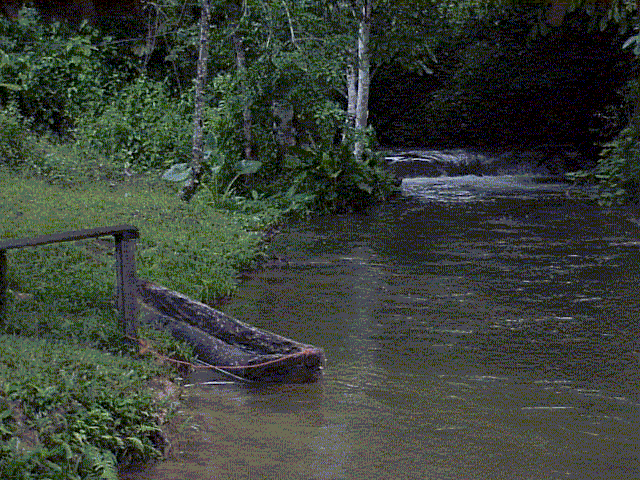
In the newer villages, the evangelists have found it easier to Christianize the natives. In Lacanjá, the Lacandon religion has not been practiced for many years. Near the beginning of the twentieth century, many important elders died from an epidemic of yellow fever, before they could pass the traditions to their children, thus becoming susceptible to missionaries and other outside influences. Today, the Lacanjá have lost their traditional religious practices, and is a protestant evangelist community. "The faithful attend a small chapel to sing Baptist hymns translated into Lacandon Maya" (Hach Winik).
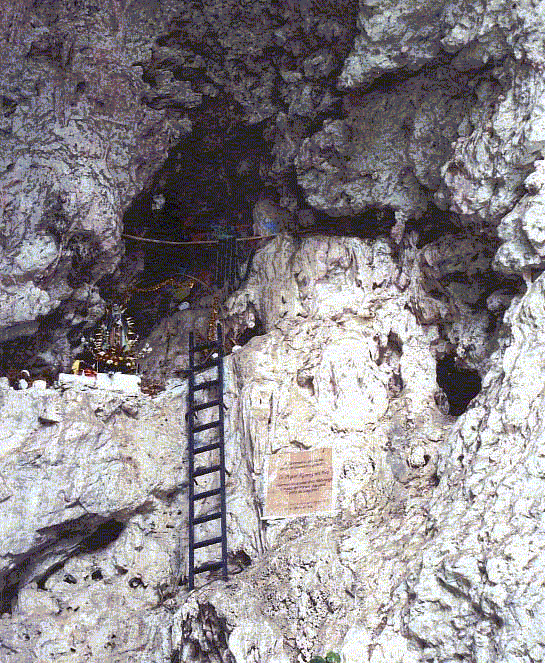
In the village of Metzabók (a.k.a. Mensäbäk, Metzaboc) the missionaries have had some success. This may be because they resort to dirty tactics such as denying non-Christians medical aid. Metzabók is also the site of many sacred prehistoric rock paintings. Lacandón converts, allegedly under the discretion of the missionaries, are often blamed for the destruction of many sacred sites such as these, as well as ancient cave burials, and desecrating traditional graves, because these sites are sacred to the traditional Lacandones (Hach Winik, Renshaw The Death of Chan K'in).
Religious Synchrotism
Interestingly, the traditional Lacandon religion and pantheon is as it was before, but it has one new addition:
Hesuklistos- a.k.a. Jesus Christ. Hesuklistos is a minor god to the Lacandon, a god of the foreigners and thus the son of Äkyantho', the god of foreign people and objects. By adding him to their pantheon, they show that they tolerate the other religion, but that he is not their god. Most Lacandon refuse to follow one whom they perceive to be a minor god (Hach Winik).

Sacred Material Culture
Some traditions among the Lacandon have remained relatively unchanged. They still use the yatoch k'un (god house), and they still burn incense, balche, and foods (such as nahwah (meat-filled tortillas), sak'ha (sweet corn gruel with honey), or kakaoh (a chocolate drink)) in the lak-il k'uh (a.k.a. incense burners or "god pots") as offerings to the gods (Hach Winik).
The women still weave images of their gods, and sacred symbols such as toads (icons of the rain god) into their weavings. However, some synchrotism has occurred here- some Maya now weave Christian symbols into their brocades such as the Virgin Mary or Saints (Maya Adventure). "Although instrumental music no longer plays an important part in Lacandon rituals, rattles, conch shell trumpets, and drums are all made by the Lacandones and occasionally have ceremonial use. They make a combination drum and incense burner that is dedicated to Kayum, god of music" (Hach Winik).
As mentioned before, some sites have been desecrated. For instance, the cave shrines on Lake Itsanok'uk near Metzabok were sites covered in red paintings of animals and anthropomorphic figures, and held old incense burners and human skeletal remains, which were said to be the remains of gods who took human form. As of December 1995, the bones had mysteriously disappeared (Hach Winik).
Changes and Culture Loss
Western technologies have also begun to affect the Lacandon. According to Renshaw, "Medicine, roads, and education are vital for [the survival of the Lacandon in the] modern world, but they are also powerful vehicles of change." Upon watching a television program explaining our solar system, one of the sons of Chan K'in was angry, saying that his father had lied when he taught him that the sun passes each night through Yaralum (Renshaw The Death of Chan K'in).
Today, rituals are not performed as often and fewer people participate (Renshaw The Death of Chan K'in). Maya have embraced western medicine to combat the many unfamiliar diseases that plagued them, but at the expense curing rituals, and the knowledge of medicinal properties of local herbs (Duby 279-280). Today several Lacandon know how to give injections (Duby 276). When they become ill, some may choose to first placate the gods with ceremonies in the god house, but afterwards they almost all will go to the local clinic for western medicine (Hach Winik).
Many
hunting rituals and other rainforest rites have lost their meaning to the
Lacandon as they shift from a subsistence based economy to one based on
selling crafts and tourism (Renshaw The
Death of Chan K'in).
The Lacandon are "[a]ware of the way they are still perceived and
portrayed, [and] many have become `professional savages.' Occasionally,
even a traditional ceremony is initiated at a filmmaker's paid request.
Tourists and filmmakers are important to the Nahá economy and they
redirect, if only momentarily, young Lacandónes' attention to their own
cultural heritage... When rites and rituals are performed in the absence
of outsiders, they are indicators of a viable faith. Of the six
traditional, thatched-roofed temples used for religious activities at Nahá,
two have fallen into disuse since Chan K'in's death. Ceremonies continue,
however, in the remaining four temples and in remote jungle sites far from
tourists and filmmakers. Many sacred sites lie on lands now allocated by
the government to farming and ranching settlements. Nevertheless, when
Lacandónes trek near the ruined homes of gods, some will stop to make
offerings among temple stones now scattered by looters" (Renshaw The
Death of Chan K'in).
In
1998 T'oh, one of Chan K'in's sons, managed to
affirm his father's teachings in the eyes of the Lacandón people by
ending a drought by twice performing day-long rituals, as his late father
taught him. "The first ceremony brought rain that fell so heavily, it
extinguished the fires sweeping through the unusually dry forest. The
second ceremony brought another heavy rain that began later the same day
and lasted all night, providing desperately needed water to the crops.
Since
the death of Chan K'in, Chan K'in's first son- who is also called Chan
K'in- assumed responsibility for his father's traditional temple where he
now quietly performs his ceremonies. "He says that he will teach his
son if he wants to learn. The survival of the Lacandón culture ultimately
depends upon its perceived worth to the Lacandón youth" (Renshaw The
Death of Chan K'in). So there is hope, since many Lacandon
children remember their father's stories and will retell them with great
excitement (Hach Winik).
![]()